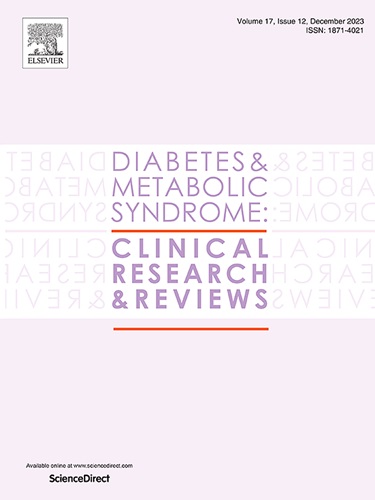Incremental risk of developing type 2 diabetes mellitus (T2D) starts at low Body Mass Index (BMI) in Asian Indians: Analysis from India Heart Watch (IHW)
IF 3.4
Q1 ENDOCRINOLOGY & METABOLISM
Diabetes & Metabolic Syndrome-Clinical Research & Reviews
Pub Date : 2025-08-01
DOI:10.1016/j.dsx.2025.103299
引用次数: 0
Abstract
Introduction
A Body Mass Index (BMI) of 23 kg/m2 is recognized as an appropriate threshold for Asian Indians to diagnose overweight and obesity, conditions associated with an increased risk of developing type 2 diabetes (T2D). We assessed the incremental risk of T2D beginning at a BMI of 18.5 kg/m2, which is below the specified threshold.
Methods
The secondary data employed in this analysis were initially gathered in the IHW study, which aimed to determine the nationwide prevalence of cardiovascular disease (CVD) risk factors among urban populations in medium-sized cities within large Indian regional states.
Results
A linear association between BMI and T2D, as determined by the Mantel-Haenszel Test, demonstrated that each incremental increase of one unit in BMI significantly elevates the risk of T2D by 28 % (Odds Ratio = 1.28, 95 % Confidence Interval [1.19, 1.37], p < .0001), commencing at a threshold of 18.5 kg/m2. This finding refutes the null hypothesis of no correlation between BMI and T2D.
Conclusion
The results of this analysis suggest that a BMI exceeding 18.5 kg/m2 may serve as a threshold for identifying individuals at an increased risk of T2D and for developing preventive strategies within the urban Asian Indian population. Nonetheless, this threshold warrants confirmation through a longitudinal investigation involving individuals with normal blood glucose levels, with particular attention to its correlation with HbA1c.
来自印度心脏观察(IHW)的分析:亚洲印度人从低身体质量指数(BMI)开始患2型糖尿病(T2D)的风险增加
体重指数(BMI)为23 kg/m2被认为是诊断超重和肥胖的适当阈值,这与患2型糖尿病(T2D)的风险增加有关。我们评估了从BMI为18.5 kg/m2开始的T2D增量风险,该值低于规定的阈值。方法本分析中使用的次要数据最初收集于IHW研究,旨在确定印度大型地区邦内中型城市城市人口中心血管疾病(CVD)危险因素的全国患病率。结果:根据Mantel-Haenszel检验,BMI与T2D呈线性相关,BMI每增加一个单位,T2D的风险显著升高28%(优势比= 1.28,95%可信区间[1.19,1.37],p < 0.0001),阈值为18.5 kg/m2。这一发现驳斥了BMI和T2D之间没有相关性的原假设。本分析结果表明,BMI超过18.5 kg/m2可作为识别亚洲印度城市人群中T2D风险增加个体和制定预防策略的阈值。尽管如此,这一阈值值得通过一项涉及正常血糖水平个体的纵向调查来证实,特别注意其与HbA1c的相关性。
本文章由计算机程序翻译,如有差异,请以英文原文为准。
求助全文
约1分钟内获得全文
求助全文
来源期刊

Diabetes & Metabolic Syndrome-Clinical Research & Reviews
ENDOCRINOLOGY & METABOLISM-
CiteScore
22.90
自引率
2.00%
发文量
248
审稿时长
51 days
期刊介绍:
Diabetes and Metabolic Syndrome: Clinical Research and Reviews is the official journal of DiabetesIndia. It aims to provide a global platform for healthcare professionals, diabetes educators, and other stakeholders to submit their research on diabetes care.
Types of Publications:
Diabetes and Metabolic Syndrome: Clinical Research and Reviews publishes peer-reviewed original articles, reviews, short communications, case reports, letters to the Editor, and expert comments. Reviews and mini-reviews are particularly welcomed for areas within endocrinology undergoing rapid changes.
 求助内容:
求助内容: 应助结果提醒方式:
应助结果提醒方式:


